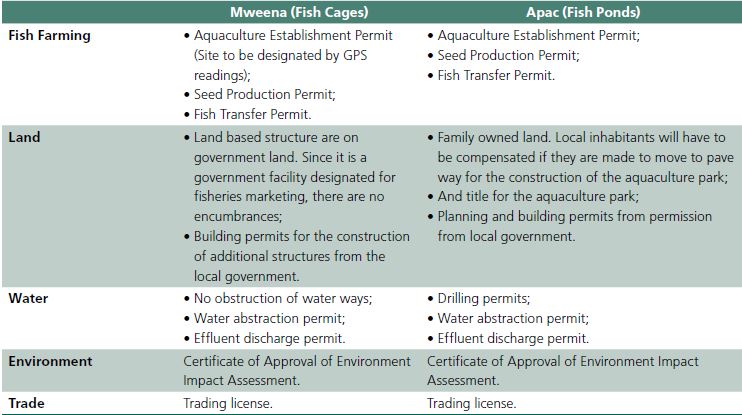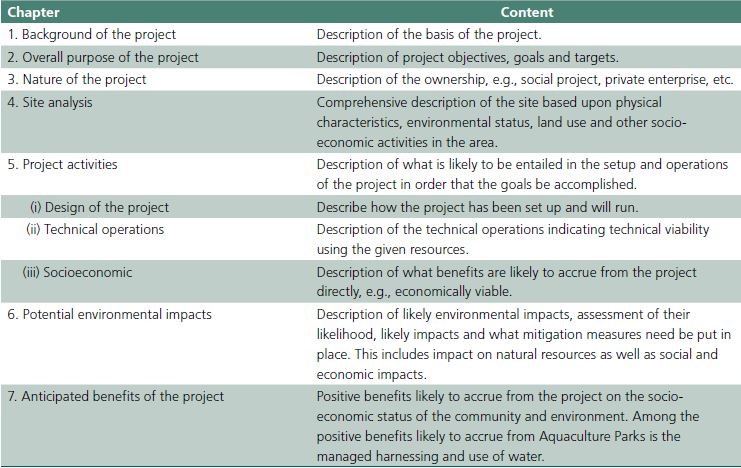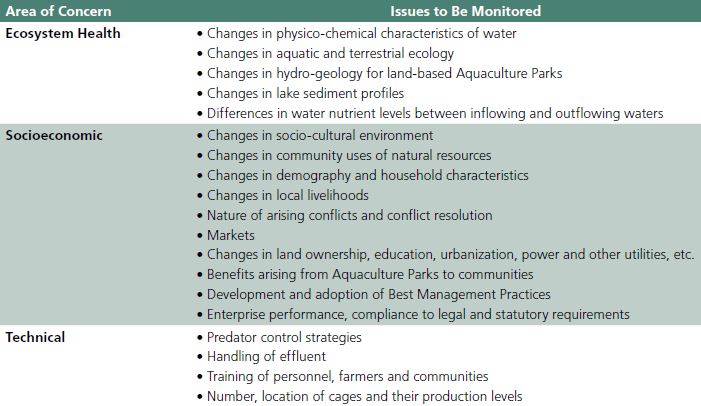5 Authorization arrangements for Aquaculture Parks
5.1 Licensing Requirements
Table 7 lists the specific regulatory requirements for aquaculture parks. The primary permits focus at monitoring aquaculture establishments, water use and environmental management (details in Annex 1).
5.2 Regulations
Currently there are no specific regulations governing Aquaculture Parks. The Aquaculture Parks are considered as aquaculture establishments with additional regulations applying as appropriate (see Tables 2 and 6). Upon their establishment, appropriate regulations can be developed depending on what management and environmental issues arise.
5.3 Environmental Impact Assessments
The following are potential environmental issues likely to arise from pond aquaculture parks (Table 8).
Table 9 below lists the groups recommended mitigation measures arising from the proposed marine cage park at Mweena.
An environmental permit would need to be obtained for all sites that address environmental, socioeconomic and governance issues. The initial step in the environmental assessment is scoping out where an environmental brief that identifies potential benefits and risks is produced. The contents of an Environmental Brief are set out by law (Table 10). The outcome would be a project brief that shall be reviewed to ascertain whether or not an Environmental Impact Assessment should be undertaken and what should be considered within it. Environmental Brief’s are reviewed by the various key agencies and stakeholders who provide their feedback to NEMA for a final decision.
Given that Aquaculture Parks are large scale operations, a full EIA will be required. This will entail that the status of the environment prior to the implementation
Table 7. Specific regulatory requirements for Aquaculture Parks.

Table 8. Environmental issues arising from pond Aquaculture Parks.
Table 9. Issues arising from cage Aquaculture Parks.
Table 10. Outline of the environmental brief.
Table 11. Template for compliance and monitoring plan.
of the project is ascertained, necessitating an environmental baseline survey. Out of this, the main drivers likely to cause environmental changes during the construction, operation and maintenance phases of the Aquaculture Parks shall be identified. A compliance and monitoring plan is consequently developed (Table 11). Upon the approval of this, the EIA permit shall be granted.
Table 12 gives a summary of what parameters are likely to be required for in the Aquaculture Parks EIA based upon the issues raised form the Aquaculture Parks feasibility study (EU/MAAIF, 2013).
5.3.1 Ecological Carrying Capacity
The ecological limits for carrying capacity within the selected Aquaculture Parks pilot sites were calculated based on results from the previous USAID FISH project (Auburn University, 2009).
Table 12. Issues to be monitored.

Pond Culture
The carrying capacity for tilapia ponds averaging 1-m deep under static green water and fed nutritionally completely floating diets was found to average 10 tonnes per hectare. The carrying capacity of catfish ponds averaging 1-m deep under static water (without fertilization) fed nutritionally completely extruded floating diets was found to average 20 tonnes per hectare.
Cage Culture
For tilapia raised in LVHD cages 150–200 kg/m3, data on cage performance was obtained from cages set within open water bodies (Lake Victoria) and farm dams. The carrying capacity was taken as the point from which total increase in cage biomass ceased to increase and key water quality parameters started to consistently become limiting factors for fish performance, notably dissolved oxygen and ammonia. This together with an analysis of the long-term sustainable production results from a commercial cage LVHD farm in Lake Victoria (Source of the Nile) revealed that an annual production of 175 tonnes per hectare of lake was the sustainable carrying capacity.
A definitive assessment of what zonal carrying capacities are likely to be can only be obtained after the EIA analysis. Aquaculture Park operations and management should accordingly be flexible to ensure adaptability to EIA requirements for sustainability.